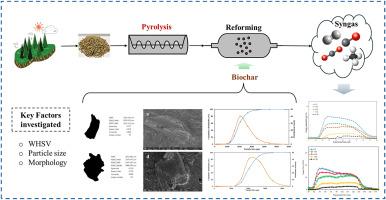Syngas production from biomass pyrolysis followed by in-line biochar-catalytic reforming: the effect of space velocity, particle size, and morphology
IF 5.8
2区 生物学
Q1 AGRICULTURAL ENGINEERING
引用次数: 0
Abstract
A continuous pyrolysis combined with an in-line biochar-catalytic reforming of the pyrolysis vapor was investigated in a comprehensive system consisting of an auger reactor and a downstream fixed-bed reactor. The effect of the weight hourly space velocity (WHSV), particle size and morphology of biochar, and the pressure drop of the biochar bed on the catalytic performance were discussed in this study. Results showed that lower WHSV, which allows longer residence time, led to higher syngas yield and increased H2+CO proportion. The use of the smallest biochar particles (0.6–1 mm) produced the highest syngas and H2 yields, correlating with the greatest pressure drops. Spherical and rounded biochar particle shape enhanced syngas and H2 yields, as well as H2+CO proportions, due to improved heat and mass transfer. A maximum of 12 mmol H2/g-biomass was achieved, with a dry gas yield of 0.68 Nm3/kg, comprising 39 vol % H2 and 27 vol % CO, at the use of pelletized biochar with a WHSV of 0.51. The used biochar demonstrated stable catalytic performance as a reforming catalyst in a 100-min test period.

生物质热解制合成气后的在线生物炭催化重整:空速、粒径和形态的影响
在由螺旋反应器和下游固定床反应器组成的综合系统中,研究了连续热解结合生物炭在线催化重整热解蒸汽的工艺。研究了生物炭的质量小时空速(WHSV)、粒径、形态、床压降等因素对催化性能的影响。结果表明,较低的WHSV可延长停留时间,从而提高合成气产量和H2+CO比例。使用最小的生物炭颗粒(0.6-1 mm)产生最高的合成气和氢气产量,与最大的压降相关。球形和圆形的生物炭颗粒形状提高了合成气和H2的产量,以及H2+CO的比例,因为它改善了传热和传质。在使用WHSV为0.51的颗粒状生物炭时,最大可获得12 mmol H2/g-生物质,干气产率为0.68 Nm3/kg,包括39 vol % H2和27 vol % CO。在100 min的测试周期内,生物炭作为重整催化剂表现出稳定的催化性能。
本文章由计算机程序翻译,如有差异,请以英文原文为准。
求助全文
约1分钟内获得全文
求助全文
来源期刊

Biomass & Bioenergy
工程技术-能源与燃料
CiteScore
11.50
自引率
3.30%
发文量
258
审稿时长
60 days
期刊介绍:
Biomass & Bioenergy is an international journal publishing original research papers and short communications, review articles and case studies on biological resources, chemical and biological processes, and biomass products for new renewable sources of energy and materials.
The scope of the journal extends to the environmental, management and economic aspects of biomass and bioenergy.
Key areas covered by the journal:
• Biomass: sources, energy crop production processes, genetic improvements, composition. Please note that research on these biomass subjects must be linked directly to bioenergy generation.
• Biological Residues: residues/rests from agricultural production, forestry and plantations (palm, sugar etc), processing industries, and municipal sources (MSW). Papers on the use of biomass residues through innovative processes/technological novelty and/or consideration of feedstock/system sustainability (or unsustainability) are welcomed. However waste treatment processes and pollution control or mitigation which are only tangentially related to bioenergy are not in the scope of the journal, as they are more suited to publications in the environmental arena. Papers that describe conventional waste streams (ie well described in existing literature) that do not empirically address ''new'' added value from the process are not suitable for submission to the journal.
• Bioenergy Processes: fermentations, thermochemical conversions, liquid and gaseous fuels, and petrochemical substitutes
• Bioenergy Utilization: direct combustion, gasification, electricity production, chemical processes, and by-product remediation
• Biomass and the Environment: carbon cycle, the net energy efficiency of bioenergy systems, assessment of sustainability, and biodiversity issues.
 求助内容:
求助内容: 应助结果提醒方式:
应助结果提醒方式:


